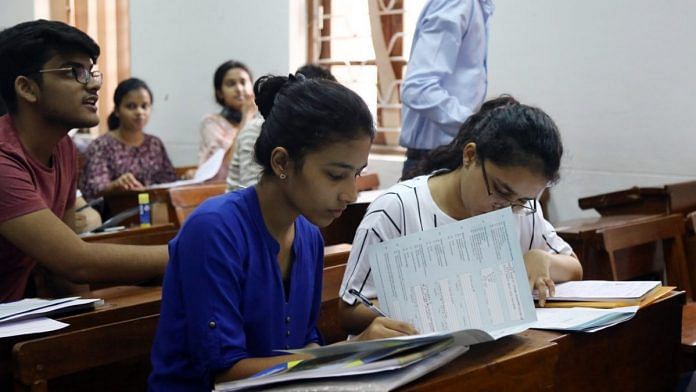New Delhi: The Narendra Modi government wants to establish public universities for liberal arts education on par with the Indian Institutes of Technology (IITs) and Indian Institutes of Management (IIMs). These institutions will focus on multi-disciplinary research and education.
This has been mentioned in the final version of the New Education Policy (NEP) document, which has been accessed by ThePrint. The document is an improvised version of the draft submitted to the government by an expert panel led by eminent scientist K. Kasturirangan in May this year.
The document will, however, be modified further before it goes for Cabinet approval, a senior HRD official said.
The proposed liberal arts universities will be called MERUs (Multidisciplinary Education and Research Universities) and will be set up with the aim to reach the global status of Ivy League universities in the United States.
“They will help set the highest standards for liberal education across India,” the document states.
IITs will have to include liberal arts in curriculum
So far, there are only private liberal arts universities in the country, including Azim Premji University, Ashoka University, O.P. Jindal University, among others, that have multi-disciplinary curriculum and offer flexibility of changing subjects.
The government will establish its own liberal arts institutes by consolidating and restructuring existing institutions, and building new ones, including establishing new world-class model institutions across the country.
According to the government, a liberal arts university is an institution having a large multi-disciplinary university, which will have flexibility in curriculum and rigorous specialisation in a single or multiple subjects.
These institutions will have departments in languages, literature, music, philosophy, indology, art, dance, theatre, education, mathematics, statistics, pure and applied sciences, sociology, economics, sports, and other such subjects.
The final policy also says that single-stream higher education institutions will have to move towards becoming multi-disciplinary. Even institutions like the IITs will have to include liberal arts in their curriculum.
It also says that admission to all undergraduate programmes in higher education institutions will be through exams conducted by the National Testing Agency to eliminate the burden of numerous overlapping entrance exams developed separately by each institution.
The policy also talks about giving weightage to national competitions such as Olympiads, topic-centred summer programmes, including sports programmes, etc. They will also be taken into account for admission to higher education institutions, especially the IITs and NITs.
Also read: Modi govt pushing for liberal arts should first learn from China on what not to do
RTE Act will be expanded to Class XII
In schools, it has been decided that the Right to Education (RTE) Act will expand from the current age of three years to Class XII to cover the entire spectrum of a child’s school years.
“To ensure that all students, particularly students from underprivileged and disadvantaged sections, have a guaranteed opportunity to participate in high-quality schooling from early childhood education (age 3 onwards) through higher secondary education (i.e., until Grade 12), the right to free and compulsory education in the RTE Act will be considered for extension downwards to include up to three years of early childhood education prior to Grade 1, and upwards to include Grades 11 and 12,” the final policy states.
Medium of instruction should be mother tongue until Class VIII
Removing any context about the imposition of Hindi in schools, the final document says the medium of instruction should be the home language/mother tongue/local language until Class VIII.
“Thereafter, the language shall continue to be taught as a language wherever possible. High-quality textbooks, including in science, will be made available in home languages,” the document further says.
It also adds that teachers will be encouraged to use a bilingual approach.
The draft NEP had triggered a raging debate about the Centre’s perceived attempts to impose Hindi on all states.
When the first draft was made public on 31 May, a controversy had erupted over the three-language formula. A line in the policy draft was misinterpreted as the government’s stand on making Hindi compulsory for all states.
The provision had kicked up a huge uproar in states such as Tamil Nadu and Karnataka, which criticised it as an attempt to thrust Hindi on them.
The three-language formula spells out that students learn their mother tongue or a regional language, the official language of the union (English) or the associate official language of the union (Hindi), and a modern Indian language.
In Hindi-speaking states, the formula translated into learning Hindi, English and a modern Indian language (preferably south Indian). For students in non-Hindi speaking states, it mandated lessons in Hindi, English and the regional language.
Also read: How to dress, speak — grooming tips now must for IIT graduates before placement interviews




Liberal concept gives a multidisciplinary approach to education system which helps in overall growth of students….. It is a very beneficial step to spike the level of education.
Education need a change
Fyi, English is the associate language of union, not hindi. Its opposite. Was it deliberate mistake? Or just incompetency?
We have a young liberal arts college founded by Mr Raghuram Rajan …it is called Krea University and it is near Chittor Andrapradesh